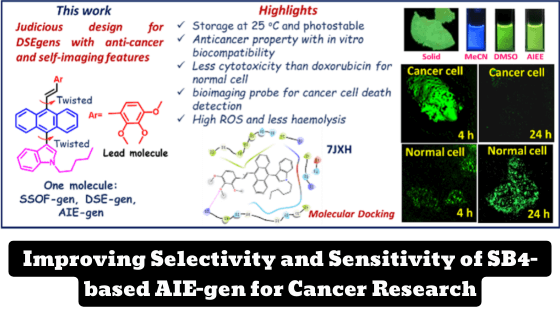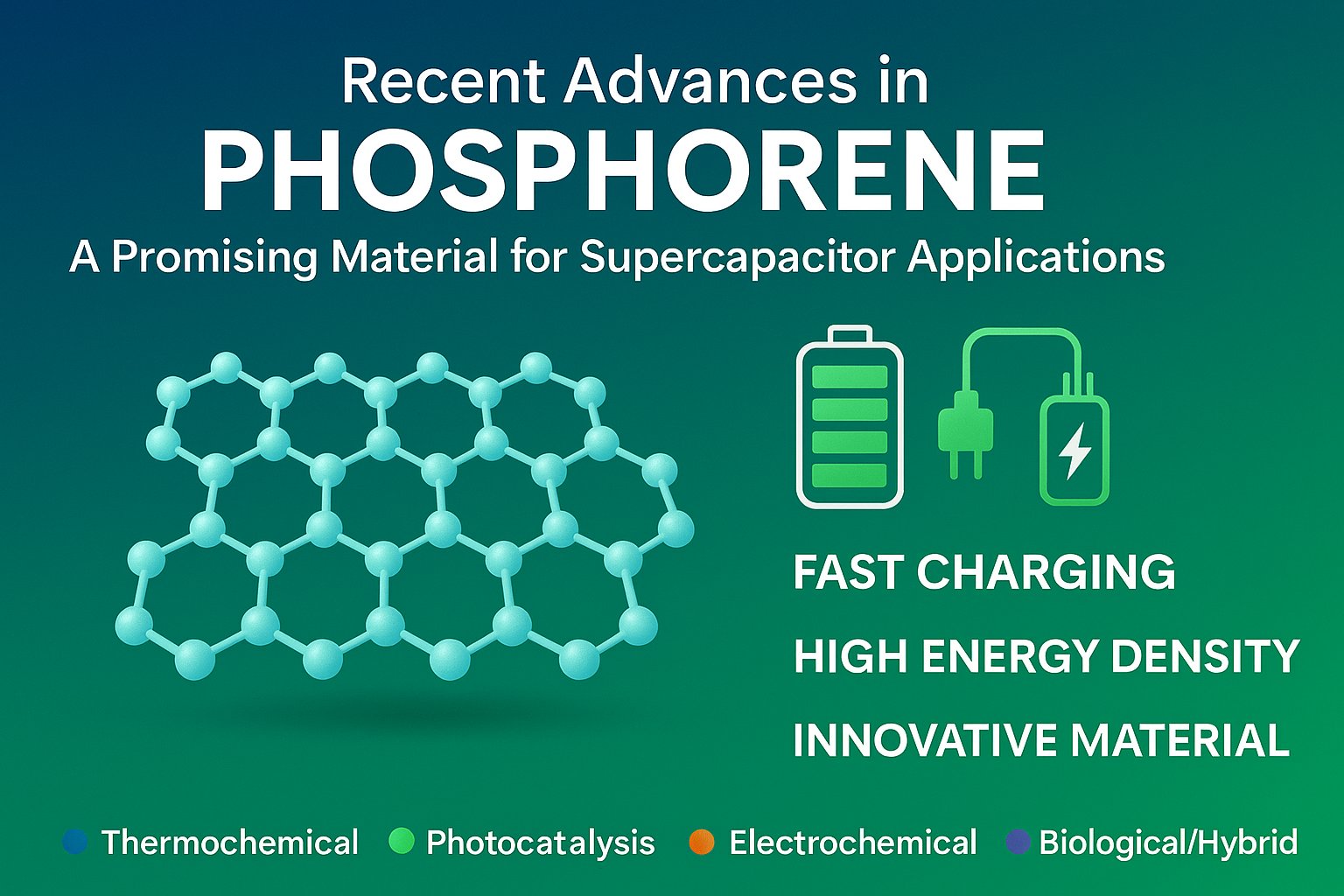A novel indole-anthracene-based fluorophore, SB4, has been successfully synthesized and characterized through X-ray diffraction (XRD), scanning electron microscopy (SEM), and UV-Vis spectroscopy.
Bullet Point Summary:
- New class of N-alkyl indole-linked anthracenyl twisted π-conjugates as efficient DSE-gens.
- In vitro anticancer properties against aggressive and robust FaDu and TNBC 4T1 cell lines.
- SB4 showed potential as an AIE-active DSE-gen with high anticancer activity and biocompatibility with imaging capability.
- Intrinsically anticancer indole and anthracene with affinity to HER2 protein.
- Hydrophobicity of the lead probe may have assisted in penetrating the cell membrane for closer interaction and imaging.
- Offers a promising solution for selectively killing cancer cells and detecting damaged cells through diminished fluorescence signals.
The AIE(E)-active DSE-gens SB1, SB2, SB4, SB6, and SB7 were evaluated for their potential as cancer-inhibiting molecules with bioimaging abilities against FaDu, 4T1, and HEK- 293 cancer cell lines using MTT assay. The in vitro cytotoxicity of SB4 was evaluated against the FaDu cell line, the 4T1 triple-negative breast cancer cell line (TNBC), and the MCF-7 non-TNBC cell line. The results showed that the anticancer activity of SB4 was significantly higher than that of the DSE gene SB1 against 4T1 and had favorable anti-cancer activities against HEK 293 with less cytotoxicity than DOX for hepatocellular carcinoma normal cells.
This work introduces a new class of N-alkyl indole-linked anthracenyl twisted π-conjugates as efficient DSE-gens and showcases their potential in challenging cancer research. SB4, in particular, exhibited potential as an AIE-active DSE-gen with high anticancer activity and biocompatibility with imaging capability. The intrinsically anticancer indole and anthracene played a crucial role in providing anticancer features with their affinity to HER2 protein, as suggested by the primary docking studies. The hydrophobicity of the lead probe may have assisted in penetrating the cell membrane for a closer interaction and imaging of the cells with DSE properties.
This research offers a promising solution for selectively killing cancer cells and detecting damaged cells through diminished fluorescence signals. Finding a detailed mechanistic path to decipher the selectivity of 4T1 and modification of the probe to improve sensitivity and specificity is currently underway in the laboratory.
Outcomes:
- Successful synthesis and characterization of a novel indole-anthracene-based fluorophore, SB4, through X-ray diffraction, scanning electron microscopy, and UV-Vis spectroscopy.
- Evaluation of SB4 as an AIE-active DSE-gen with potential cancer-inhibiting properties and bioimaging abilities against FaDu, 4T1, and HEK- 293 cancer cell lines using MTT assay.
- Higher anticancer activity of SB4 compared to the DSE gene SB1 against 4T1 and favorable anti-cancer activities against HEK 293 with less cytotoxicity than DOX for hepatocellular carcinoma normal cells.
Solid-state emitting twisted p-conjugate as AIE-active DSE-gen: in vitro anticancer properties against FaDu and 4T1 with biocompatibility and bioimaging
Bhuin; Sharma; Chakraborty; Kulkarni; Chakravarty 2023
Full-text link: https://doi.org/10.1039/d2tb02078e
What this paper is about
- Nevertheless, many admirable anticancer drugs are available, but with no bioimaging ability, while numerous bioimaging agents are known without anticancer properties.
- The pyridyl-linked emitters are active against FaDu and 4T1 but are cytotoxic to normal cell lines.
- Apart from inhibiting, the TMB-linked emitter could image both FaDu and 4T1 cell lines with green emission before cell death but the fluorescence signal was diminished 24 h after cell death.
What you can learn
- The organic layer was separated, passed through a Na 2 SO 4 layer, and made into a slurry with silica gel to perform column chromatography ), which yielded Synthesis of-4-anthracen-9yl)vinyl)-N,N-diphenylaniline.
- The HEK-293 normal cells and cancer cells could be easily distinguished by comparing the intensity of intact fluorescence signals.
- The intrinsically anticancer indole and anthracene play a crucial role in providing anticancer features with their affinity to HER2 protein, as suggested by the primary docking studies.
What is SB4 and how was it characterized?
Answer: SB4 is a novel indole-anthracene-based fluorophore that was successfully synthesized and characterized by X-ray diffraction (XRD), scanning electron microscopy (SEM), and UV-Vis spectroscopy.
How was the anticancer activity of SB4 evaluated?
Answer: The anticancer activity of SB4 was evaluated against FaDu, 4T1, and HEK- 293 cancer cell lines using MTT assay.
What is the in vitro cytotoxicity of SB4 compared to other cancer cell lines and normal cells? Answer: The in vitro cytotoxicity of SB4 was evaluated against the FaDu, 4T1, MCF-7 cell lines and normal cells of hepatocellular carcinoma (HCC). The results showed that SB4 had significantly higher anticancer activity against 4T1 than the DSE gene SB1 and was less cytotoxic than DOX for normal cells.
What makes SB4 a promising biocompatible drug with imaging capability?
Answer: SB4 is a promising biocompatible drug with imaging capability due to its noncytotoxicity, high ROS generation, and less haemolysis. Its hydrophobicity assists in penetrating the cell membrane to form a closer interaction and provide an image of the cells with DSE properties.
What is the role of indole and anthracene in providing anticancer features to SB4?
Answer: The intrinsically anticancer indole and anthracene play a crucial role in providing anticancer features to SB4 due to their affinity to HER2 protein, as suggested by primary docking studies.
What is the significance of the SB4 research?
Answer: The research on SB4 highlights the prospects of newly designed DSE-gens in challenging cancer research and offers a promising solution to kill cancer cells selectively and detect damaged cells through diminished fluorescence signals. Further research is underway to decipher the selectivity of 4T1 and improve the sensitivity and specificity of the probe.




